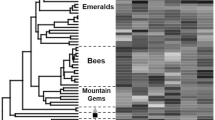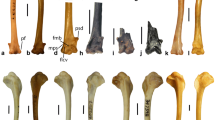Abstract
In the context of a recently published phylogenetic estimate for 151 hummingbird species, we provide an expanded informal taxonomy, as well as a formal phylogenetic taxonomy for Trochilidae that follows the precepts of the PhyloCode, but remains consistent with the hierarchical nomenclature of the Linnaean system. We compare the recently published phylogenetic hypothesis with those of prior higher-level and more taxonomically circumscribed phylogenetic studies. We recommend the recognition of nine new clade names under the PhyloCode, eight of which are consistent with tribes and one with a subfamily under the Linnaean system.

Similar content being viewed by others
References
Altshuler DL, Dudley R, McGuire JA (2004) Resolution of a paradox: hummingbird flight at high elevation does not come without a cost. Proc Natl Acad Sci USA 101:17731–17736. doi:10.1073/pnas.0405260101
American Ornithologists’ Union (1998) Check-list of North American birds, 7th edn. American Ornithologists’ Union, Washington
Bleiweiss R, Kirsch JAW, Matheus JC (1994) DNA-DNA hybridization evidence for subfamily structure among hummingbirds. Auk 111:8–19
Bleiweiss R, Kirsch JAW, Matheus JC (1997) DNA hybridization evidence for the principal lineages of hummingbirds (Aves: Trochilidae). Mol Biol Evol 14:325–343
Bleiweiss R, Hendrickson S, Berres ME, Willis YO, Willis EO (2003) Affinities of the saw-billed hermit (Ramphodon naevius) as determined by cytochrome-b sequence data. Wilson Bull 115:1–10. doi:10.1676/02-024
Dickinson EC (2003) The Howard & Moore complete checklist of the birds of the world, 3rd edn. Princeton University Press, Princeton
García-Moreno J, Actander P, Fjeldså J (1999) Strong diversification at the treeline among Metallura hummingbirds. Auk 116:702–711
García-Moreno J, Cortés N, García-Deras GM, Hernández-Baños BE (2006) Local origin and diversification among Lampornis hummingbirds: a Mesoamerican taxon. Mol Phylogenet Evol 38:488–498. doi:10.1016/j.ympev.2005.08.015
Gerwin JA, Zink RM (1998) Phylogenetic patterns in the Trochilidae. Auk 115:105–118
Gill FB, Gerwin JA (1989) Protein relationships among hermit hummingbirds. Proc Acad Nat Sci Phila 141:409–421
Gould J (1861) A monograph of the Trochilidae or family of hummingbirds, vol 1–5. Taylor and Francis, London
Graves GR (1980) A new species of metaltail hummingbird from northern Peru. Wilson Bull 92:1–7
Heindl M, Schuchmann K-L (1998) Biogeography, geographical variation and taxonomy of the Andean hummingbird genus Metallura Gould, 1847. J Ornitologie 139:425–473. doi:10.1007/BF01653470
Hinkelmann C, Schuchmann K-L (1997) Phylogeny of the hermit hummingbirds (Trochilidae: Phaethornithinae). Stud Neotrop Fauna Environ 32:142–163
Joyce WG, Parham JF, Gauthier JA (2004) Developing a protocol for the conversion of rank-based taxon names to phylogenetically defined clade names, as exemplified by turtles. J Paleontol 78:989–1013. doi:10.1666/0022-3360(2004)078<0989:DAPFTC>2.0.CO;2
Lesson R-P (1833) Les Trochilidees; ou, Les Colibris et les Oiseaux-Mouches, suivis d’un index general dans lequel sont decrits et classes methodiquement toutes les races et especes du genre Trochilus. Ouvrage Orne de Planches Dessinees et Gravees par les meilleurs artistes. Bertrand, Paris
Linnaeus C (1758) Systema naturaeper regna tria naturae, 10th edn, rev. 2 vols. Laurentii Salmii, Holmiae
Linnaeus C (1766) Systema naturæ per regna tria naturæ, secundum classes, ordines, genera, species, cum characteribus, differentiis, synonymis, locis. Tomus I. Editio duodecima, reformata. Laurentii Salvii, Holmiæ
Mayr G (2003a) A new Eocene swift-like bird with a peculiar feathering. Ibis 145:382–391. doi:10.1046/j.1474-919X.2003.00168.x
Mayr G (2003b) Phylogeny of early Tertiary swifts and hummingbirds (Aves: Apodiformes). Auk 120:145–151. doi:10.1642/0004-8038(2003)120[0145:POETSA]2.0.CO;2
Mayr G (2004) Old World fossil record of modern-type hummingbirds. Science 304:861–864. doi:10.1126/science.1096856
McGuire JA, Witt CC, Altshuler DL, Remsen JV Jr (2007) Phylogenetic Systematics and biogeography of hummingbirds: Bayesian and maximum-likelihood analyses of partitioned data and selection of an appropriate partitioning strategy. Syst Biol 56:837–856. doi:10.1080/10635150701656360
Meyer de Schauensee R (1966) The species of birds of South America and their distribution. Livingston, Narbeth
Pallas PS (1764) Catalogue raisonne, d’une collection supérieurement belle d’oiseaux, tant exotiques qu’Europe’ens, de quadrepèdes et d’insectes. Adumbratiunculae, pp 1–7
Peters JL (1945) Check-list of the birds of the world, 5th edn. Harvard University Press, Cambridge
PhyloCode (2006) International code of phylogenetic nomenclature, Version 3a. http://www.ohiou.edu/phylocode/preface.html
Remsen JV Jr, Jaramillo A, Nores M, Pacheco JF, Robbins MB, Schulenberg TS et al (2007) A classification of the bird species of South America. American Ornithologists’ Union. Available at: http://www.museum.lsu.edu/~Remsen/SACCBaseline.html (Assessed 13 Jun 2007)
Renner SC, Schuchmann K-L (2004) Biogeography, geographical variation, and taxonomy of the hummingbird genera Eugenes Gould, 1856, Sternoclyta Gould, 1858, and Hylonympha Gould, 1873 (Aves: Trochilidae). Ornithol Anz 43:103–114
Schuchmann K-L (1985) Schillerkolibris (Aglaeactis sp.). Trochilus 6:2–8
Schuchmann K-L (1995) Taxonomy and biology of the Tooth-billed Hummingbird Androdon aequatorialis. Mitt Zool Mus Berl 71 Suppl Ann Orn 16:109–113
Schuchmann K-L (1997) The display of the Booted Racket-tailed Hummingbird Ocreatus underwoodii, with notes on the systematic position of the genus. Bull Br Ornithol Club 107:20–22
Schuchmann K-L (1999) Family Trochilidae (hummingbirds). In: del Hoyo J, Elliot A, Sargatal J (eds) Handbook of the birds of the world, vol 5: barn-owls to hummingbirds. Lynx, Barcelona, pp 468–680
Schuchmann K-L, Heindl M (1997) Biogeographie, geographische Variation und Taxonomie der andinen Kolibrigattung Chalcostigma Reichenbach, 1854. Mitt Zool Mus Berl 73. Suppl Ann Orn 21:131–153
Schuchmann K-L, Weller A-A, Heynen I (2001) Biogeography and geographic variation of the Andean hummingbird taxon Boissonneaua Reichenbach, 1854 (Aves, Trochilidae). Ornitol Neotrop 12:93–108
Swainson W (1827) A synopsis of the birds discovered in Mexico by W. Bullock, F. L. S., and H. S., Mr. William Bullock, jun. The Philosophical Magazine, or Annals of Chemistry, Mathematics, Astronomy, Natural History, and General Science, New series 1(5):364–369, 433–442
Vieillot LJP (1824) La Galerie des Oiseaux du cabinet d’histoire naturelle du jardin du roi. Aillard & Constant-Chantpie, Paris, pp 1822–1825
Vigors NA (1825) Descriptions of some rare, interesting, or hitherto uncharacterized subjects of zoology. Zool J Lond 1(409–418):526–542
Weller A-A (2000) Biogeography, geographic variation, and taxonomy of the Neotropical hummingbird genus Polyerata Heine, 1863 (Aves: Trochilidae). Bonn Zool Monogr 46:47–54
Willis EO, Schuchmann K-L (1993) Comparison of cloud-forest avifaunas in southeastern Brazil and western Colombia. Ornitol Neotrop 4:55–63
Wyss AR, Meng J (1996) Application of phylogenetic taxonomy to poorly resolved crown clades: a stem-modified node-based definition of Rodentia. Syst Biol 45:559–568. doi:10.2307/2413531
Zusi RL, Bentz GD (1982) Variation in a muscle in hummingbirds and swifts and its systematic implications. Proc Biol Soc Wash 95:412–420
Acknowledgments
This research was supported by National Science Foundation grants (DEB 0330750 and DEB 0543556) issued to J.A.M. and R.D. The original phylogenetic study would not have been possible without the assistance of the following institutions, curators, and staff who provided samples under their care: the Academy of Natural Sciences (Leo Joseph, Nate Rice), American Museum of Natural History (George Barrowclough, Joel Cracraft, Paul Sweet), Burke Museum of Natural History (Shannon Birks, Scott Edwards), Field Museum of Natural History (John Bates, Shannon Hackett, David Willard), National Museum of Natural History (Mike Braun, Gary Graves, Chris Huddleston), University of Kansas Museum of Natural History (Mark Robbins, Town Peterson), University of Michigan Museum of Zoology (David Mindell, Janet Hinshaw), STRI (Biff Bermingham, Maribel Gonzáles), and the Zoological Museum Copenhagen (Jon Fjeldså, Jan Kristensen, Rudolf Meier). Michael Roy graciously provided uncatalogued samples of Sephanoides fernandensis that otherwise would not have been available. Donna Dittmann and Steve Cardiff of the Louisiana State University Museum of Natural Science provided invaluable assistance confirming identifications of many voucher specimens under their care.
Author information
Authors and Affiliations
Corresponding author
Additional information
Communicated by J. Fjeldså.
Rights and permissions
About this article
Cite this article
McGuire, J.A., Witt, C.C., Remsen, J.V. et al. A higher-level taxonomy for hummingbirds. J Ornithol 150, 155–165 (2009). https://doi.org/10.1007/s10336-008-0330-x
Received:
Revised:
Accepted:
Published:
Issue Date:
DOI: https://doi.org/10.1007/s10336-008-0330-x




